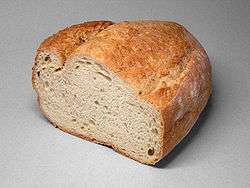Sandwich
A sandwich is a food typically consisting of vegetables, sliced cheese or meat, placed on or between slices of bread, or more generally any dish wherein bread serves as a container or wrapper for another food type.[1][2][3] The sandwich began as a portable finger food in the Western world, though over time it has become prevalent worldwide.
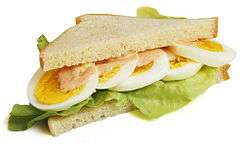 An egg sandwich | |
| Main ingredients | Bread, meat, cheese, salad vegetables, sauce or savoury spread |
|---|---|
Sandwiches are a popular type of lunch food, taken to work, school, or picnics to be eaten as part of a packed lunch. The bread may be plain or be coated with condiments, such as mayonnaise or mustard, to enhance its flavour and texture. As well as being homemade, sandwiches are also widely sold in restaurants and can be served hot or cold.[4][5] There are both savoury sandwiches, such as deli meat sandwiches, and sweet sandwiches, such as a peanut butter and jelly sandwich.
The sandwich is named after its supposed inventor, John Montagu, 4th Earl of Sandwich.[6][7] The Wall Street Journal has described it as Britain's "biggest contribution to gastronomy."[8]
History
The modern concept of a sandwich using slices of bread as found within the West can arguably be traced to 18th-century Europe. However, the use of some kind of bread or bread-like substance to lie under (or under and over) some other food, or used to scoop up and enclose or wrap some other type of food, long predates the eighteenth century, and is found in numerous much older cultures worldwide.
The ancient Jewish sage Hillel the Elder is said to have wrapped meat from the Paschal lamb and bitter herbs in a soft matzah—flat, unleavened bread—during Passover in the manner of a modern wrap made with flatbread.[9] Flat breads of only slightly varying kinds have long been used to scoop or wrap small amounts of food en route from platter to mouth throughout Western Asia and northern Africa. From Morocco to Ethiopia to India, bread is baked in flat rounds, contrasting with the European loaf tradition.
During the Middle Ages in Europe, thick slabs of coarse and usually stale bread, called "trenchers," were used as plates.[10] After a meal, the food-soaked trencher was fed to a dog or to beggars at the tables of the wealthy, and eaten by diners in more modest circumstances. The immediate culinary precursor with a direct connection to the English sandwich was to be found in the Netherlands of the seventeenth century, where the naturalist John Ray observed[11][12] that in the taverns beef hung from the rafters "which they cut into thin slices and eat with bread and butter laying the slices upon the butter"—explanatory specifications that reveal the Dutch belegde broodje, open-faced sandwich, was as yet unfamiliar in England.
Initially perceived as food that men shared while gaming and drinking at night, the sandwich slowly began appearing in polite society as a late-night meal among the aristocracy. The sandwich's popularity in Spain and England increased dramatically during the nineteenth century, when the rise of industrial society and the working classes made fast, portable, and inexpensive meals essential.[13] In London, for example, at least seventy street vendors were selling ham sandwiches by 1850; during that decade sandwich bars also became an important form of eating establishment in western Holland, typically serving liver and salt beef sandwiches.[14]
In the US, the sandwich was first promoted as an elaborate meal at supper. By the early 20th century, as bread became a staple of the American diet, the sandwich became the same kind of popular, quick meal as was already widespread in the Mediterranean.[13]
Language
The first written usage of the English word appeared in Edward Gibbon's journal, in longhand, referring to "bits of cold meat" as a "Sandwich."[15] It was named after John Montagu, 4th Earl of Sandwich, an eighteenth-century English aristocrat. It is said that he ordered his valet to bring him meat tucked between two pieces of bread, and others began to order "the same as Sandwich!"[6][7] It is commonly said that Lord Sandwich was fond of this form of food because it allowed him to continue playing cards, particularly cribbage, while eating, without using a fork, and without getting his cards greasy from eating meat with his bare hands.[6]
The rumour in its familiar form appeared in Pierre-Jean Grosley's Londres (Neuchâtel, 1770), translated as A Tour to London in 1772;[16] Grosley's impressions had been formed during a year in London in 1765. The sober alternative is provided by Sandwich's biographer, N. A. M. Rodger, who suggests Sandwich's commitments to the navy, and to politics and the arts, mean the first sandwich was more likely to have been consumed at his desk.
Before being known as sandwiches, this food combination seems to simply have been known as "bread and meat" or "bread and cheese."[6] These two phrases are found throughout English drama from the 16th and 17th centuries.[6]
In the US, a court in Boston, Massachusetts, ruled in 2006 that a sandwich includes at least two slices of bread[1] and "under this definition, this court finds that the term 'sandwich' is not commonly understood to include burritos, tacos, and quesadillas, which are typically made with a single tortilla and stuffed with a choice filling of meat, rice, and beans."[17] The issue stemmed from the question of whether a restaurant that sold burritos could move into a shopping centre where another restaurant had a no-compete clause in its lease prohibiting other "sandwich" shops.
In Spain, where the word sandwich is borrowed from the English language,[18] it refers to a food item made with English sandwich bread.[19] It is otherwise known as a bocadillo. Similar usage applies in other Spanish-speaking cultures, such as Mexico, where the word torta is also used for a popular variety of roll-type sandwiches.
In the UK and Australia, the term sandwich is more narrowly defined than in the US: it refers usually to an item which uses sliced bread from a loaf. An item with similar fillings, but using an entire bread roll cut horizontally in half, is generally referred to as a roll, or with certain hot fillings, a burger. However, hot sliced (not ground) beef between two slices of toasted bread is referred to as a steak sandwich: it is the sliced loaf bread that distinguishes the steak sandwich from a burger.
The verb to sandwich has the meaning "to position anything between two other things of a different character, or to place different elements alternately,"[20] and the noun sandwich has related meanings derived from this more general definition. For example, an ice cream sandwich consists of a layer of ice cream between two layers of cake or biscuit.[21] Similarly, Oreos and Custard Creams are described as sandwich biscuits (UK/Commonwealth) or sandwich cookies (US) because they consist of a soft filling between the baked layers.[22]
The word butty, originally referring to a buttered slice of bread,[23] is common in some northern parts of England as a slang synonym for "sandwich," particularly to refer to certain kinds of sandwiches including the chip butty, bacon butty, or sausage butty.[24] Sarnie is a similar colloquialism.[25] Likewise, the word sanger is used for sandwich in Australian slang.[26] The colloquial Scottish word piece may refer either to a sandwich or to a light meal, especially one that includes a sandwich. For example, the phrase jeely piece refers to a jam sandwich.[27]
Pre-made sandwiches
It has been suggested that UK's first pre-made packaged sandwiches were sold by Marks & Spencer in 1980.[28] As they proved wildly popular, a small experiment involving five stores rapidly grew to cover more than one hundred stores. Within a year, the store was looking for ways to manufacture sandwiches at an industrial scale. However, the first pre-packed sandwiches date from well before this. British Home Stores sold pre-packed sandwiches in the 1960s (see the Radio Times 3 November 2018 p. 167), and earlier even than that, Marks and Spencer (Brighton branch) began selling them in the 1950s, and then in the 1960s in the Oxford Street branch, London. (See the Radio Times 10 November 2018 p. 160)
In 2017, the sandwich industry made and sold £8 billion in sandwiches in the UK alone.[28]
Varieties
Among the many varieties of sandwich popular in the United States are the BLT, cheese sandwich, club sandwich, Dagwood, French dip, hamburger, Monte Cristo, muffuletta, pastrami on rye, peanut butter and jelly sandwich, cheesesteak, pilgrim, po' boy, Reuben, sloppy joe, and submarine.[29]
Gallery
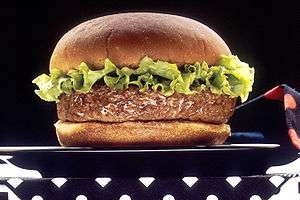
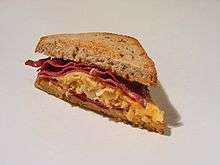

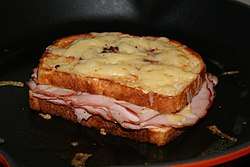 Croque-monsieur, a French ham and cheese hot sandwich
Croque-monsieur, a French ham and cheese hot sandwich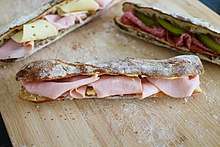 Jambon-beurre, a French ham baguette sandwich
Jambon-beurre, a French ham baguette sandwich
- A Philadelphia-style cheesesteak, a type of submarine sandwich
 Smoked meat sandwich
Smoked meat sandwich French bread sandwich with fries
French bread sandwich with fries- Sandwich making
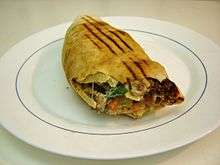 Shawarma sandwich
Shawarma sandwich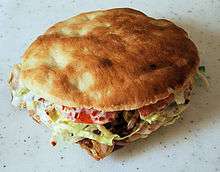 Doner sandwich
Doner sandwich Chicken breast sandwich
Chicken breast sandwich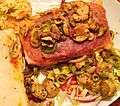
- An open sandwich with smoked horse meat in the Netherlands
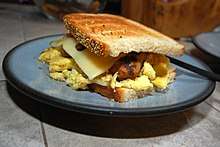 Bacon, egg and cheese sandwich
Bacon, egg and cheese sandwich Salmon-and-cream-cheese sandwiches on pieces of baguette
Salmon-and-cream-cheese sandwiches on pieces of baguette English sandwiches, crustless on a plate
English sandwiches, crustless on a plate- Sandwich filled with olives and sliced red tomatoes
 A pre-packaged sandwich
A pre-packaged sandwich House Sandwiches
House Sandwiches
See also
- Butterbrot
- Finger food
- Fuzzy concept § Sandwich example
- List of bread dishes
- List of sandwiches
- List of American sandwiches
- List of foods
- Panino (also called by the plural panini)
- Sandwich cake (layer cake)
- Sandwiches de miga
- Sarnie (British term)
- Soup and sandwich
- Tramezzino
- Vada pav
References
- Abelson, Jenn (10 November 2006). "Arguments spread thick". The Boston Globe. Archived from the original on 7 December 2008. Retrieved 27 May 2009.
- "sandwich". Merriam-Webster. Merriam-Webster, Incorporated. Retrieved 29 March 2012.
- Foundations of Restaurant Management & Culinary Arts Level Two. Pearson. 2011. p. 53. ISBN 978-0-13-138022-6.
- Foundations of Restaurant Management & Cullinary Arts Level Two. Pearson. 2011. p. 53. ISBN 978-0-13-138022-6.
- Becoming a Foodservice professional Year 1. National Restaurant Association Educational Foundation. 1999. p. 306. ISBN 1-883904-87-0.
- What's Cooking America, Sandwiches, History of Sandwiches. 2 February 2007.
- "Sandwich celebrates 250th anniversary of the sandwich". BBC News Online. 12 May 2012. Retrieved 18 May 2012.
- Marks, Kathy (17 May 1997). "BLT: British, lousy and tasteless". The Independent. London.
- Bavli Pesachim 115a; See also Passover Hagadah
- Meads, Chris (2001). Banquets set forth: banqueting in English Renaissance drama. Manchester University Press. p. 47. ISBN 0-7190-5567-9.
- Ray, John (1673). Observations topographical, moral, & physiological; made in a journey through part of the Low Countries, Germany, Italy, and France …. London, England: John Martyn. p. 51.
- Ray, Observations topographical, moral, & physiological; made in a journey through part of the Low Countries, Germany, Italy, and France … (vol. I, 1673) quoted in Simon Schama, The Embarrassment of Riches (1987:152).
- Encyclopedia of Food and Culture, Solomon H. Katz, editor (Charles Scribner's Sons: New York) 2003
- Alan Davidson and Tom Jaine (2014). The Oxford Companion to Food. Oxford University Press. p. 712. ISBN 978-0199677337.
- The Oxford English Dictionary gives its appearance as 1762.
- Grosley, Londres (Neuchatel, 1770) and A Tour to London, or, New observations on England and its inhabitants, translated from the French by Thomas Nugent (London: Printed for Lockyer Davis) 1772; Hexmasters Faktoider: Sandwich: English quotes from Grosley 1772
- White City Shopping Ctr., LP v. PR Rests., LLC, 21 Mass. L. Rep. 565 (Mass. Super. Ct. 2006)
- Collado, Asunción López (January 1994). Hostelería, curso completo de servicios. Asunción López Collado (in Spanish). ISBN 978-84-283-2035-1. Retrieved 11 July 2010.
- "Consultorio gastronómico". La Verdad Digital S.L. (in Spanish). Retrieved 21 July 2010.
- The Oxford English Dictionary
- Taste Taste: Ice Cream Sandwiches, NYmag.com
- Oreo Sandwich Biscuits, Nabiscoworld.com
- "butty, n.2" Check
|url=value (help). OED Online. Oxford University Press. June 2020.English regional (chiefly northern). Originally: a slice of bread spread with butter. Now: a filled sandwich; (also) an open sandwich. Frequently with modifying word denoting the filling or topping.
- "Butty". dictionary.com. Retrieved 13 August 2019.
- "Sarnie". dictionary.com. Retrieved 13 August 2019.
- "sanger, n." Check
|url=value (help). OED Online. Oxford University Press. June 2020.colloquial (originally and chiefly Australian). A sandwich. Frequently with modifying word.
- "Parliamo Scots? - Food". Rampant Scotland. Retrieved 28 November 2016.
- Knight, Sam (24 November 2017). "How the Sandwich Consumed Britain". The Guardian. ISSN 0261-3077. Retrieved 4 December 2017.
- Carlos, Brenda. "Fascinating Facts about the Sandwich". Chefs.com. Retrieved 5 October 2011.
